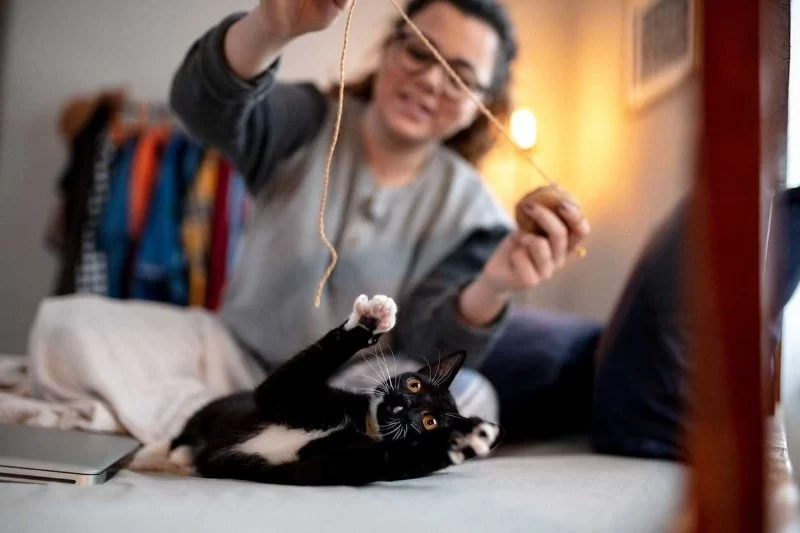1. Understanding Cat Anxiety Around New People
Cats are creatures of habit, and sudden changes to their environment—especially new people—can make them anxious. Unlike dogs, who often thrive on social interaction, cats can be territorial and cautious when strangers enter their space. Understanding what triggers your cat’s anxiety is the first step toward helping them feel secure and calm.
1.1 Why Cats Get Anxious Around Strangers
Your cat’s fear of new people usually stems from unfamiliar scents, sounds, and movements. Cats rely heavily on their sense of smell and routine to feel safe. When a new person enters their world, it disrupts that familiarity. Past experiences also play a major role. If a cat wasn’t properly socialized as a kitten or had negative experiences with strangers, they may develop lasting anxiety around unfamiliar humans.
1.2 Common Signs of Cat Anxiety
Recognizing the symptoms of anxiety in cats can help you intervene before it escalates. Typical signs include hiding, hissing, trembling, excessive grooming, or refusing to eat. Some cats may also become more vocal or exhibit defensive body language, such as puffed-up fur and flattened ears. Understanding these cues helps you respond appropriately and build trust over time.
2. Preparing Your Home for a Calm Introduction
Before your cat meets new people, it’s important to prepare their environment. Creating a safe, stress-free space can make a significant difference in how your cat reacts. Preparation helps set the stage for a smoother, more positive introduction.
2.1 Establishing a Safe Haven
Choose a quiet room where your cat feels most comfortable—this could be a bedroom, office, or cozy corner. Place familiar items such as their bed, toys, and scratching post in the area. These familiar scents and textures help reduce anxiety by providing comfort and security. If possible, add a hiding spot like a soft blanket under furniture or an open carrier, so your cat can retreat when they feel overwhelmed.
2.2 Using Calming Aids
Products like pheromone diffusers, calming sprays, or herbal treats can help reduce anxiety before guests arrive. These tools mimic natural feline pheromones that signal safety and comfort. Play soft, soothing music or keep noise levels low to maintain a calm atmosphere. At Hidden Brook Veterinary, many veterinarians recommend using these aids in combination with gradual desensitization techniques for best results.
3. Introducing Cats to New People Gradually
When it’s time for your cat to meet someone new, patience is key. Rushing the process can make your cat feel threatened, which may lead to defensive behavior or long-term fear. Instead, use gradual exposure techniques that allow your cat to approach on their own terms.
3.1 The Slow and Steady Approach
Start by letting your cat observe the new person from a distance. Encourage your guest to remain seated and avoid direct eye contact, as staring can seem threatening to cats. Let your cat sniff the air and take in the person’s scent. You can also give your guest a piece of clothing or fabric that carries their scent before the visit—this helps your cat get used to them in a low-pressure setting.
3.2 Rewarding Positive Behavior
Positive reinforcement goes a long way. If your cat approaches the new person or behaves calmly, reward them with a treat, gentle praise, or petting if they’re comfortable. Over time, your cat will associate new people with positive experiences instead of fear. Remember to keep the sessions short and always end on a positive note.
4. Managing Stress During the Visit
Even with preparation, your cat may still feel uneasy during the actual encounter. Managing stress in real time helps prevent anxiety from escalating and ensures the meeting remains a positive experience for everyone involved.
4.1 Reading Your Cat’s Body Language
Pay attention to how your cat communicates. If they retreat, flatten their ears, or flick their tail rapidly, it’s a sign they’re stressed. Allow them to move away without forcing interaction. Cats need to feel in control of their environment to stay calm. Forcing them to socialize can increase fear and create setbacks in their progress.
4.2 Using Distraction Techniques
If your cat starts feeling anxious, redirect their focus with a toy or play session. Wand toys, laser pointers, or treat puzzles can help shift their attention away from the new person and toward something enjoyable. Distraction not only reduces stress but also builds positive associations with visitors.
5. Helping Your Cat Build Confidence Over Time
Building your cat’s confidence around new people takes time and consistency. Regular exposure, when done gently, helps desensitize them to strangers and strengthens their trust in you as a protector.
5.1 Encouraging Exploration
Give your cat the freedom to explore their environment at their own pace. Confidence grows when they feel safe making their own choices. Provide vertical spaces such as cat trees or shelves where they can observe visitors from a distance. This gives them a sense of security and control.
5.2 Socialization Through Familiar Routines
Keep your cat’s routine consistent—feeding times, play sessions, and resting periods should remain the same. Predictability builds stability, which helps reduce anxiety when new factors are introduced. If you regularly host guests, your cat will gradually adapt to the pattern and learn that visitors are not a threat.
6. When Professional Help May Be Needed
In some cases, cats experience severe anxiety that requires professional intervention. If your cat shows signs of chronic stress—such as hiding for days, refusing to eat, or aggressive behavior—it may be time to consult a veterinarian or a feline behavior specialist. At Hidden Brook Veterinary, experts can assess your cat’s behavior and recommend safe, effective treatment plans, including anxiety-reducing medications or behavior modification programs.
6.1 Medication and Behavioral Therapy Options
For cats with severe anxiety, veterinarians may prescribe anti-anxiety medications to help manage symptoms while working on behavioral strategies. These treatments should always be supervised by professionals, as each cat’s condition and tolerance level vary. With patience, consistent care, and professional support, most cats can overcome social anxiety and learn to feel comfortable around new people.
7. Building a Lifetime of Calm and Trust
Helping your cat manage anxiety when meeting new people isn’t just about one-time introductions—it’s about building a lifetime of confidence and trust. With gentle exposure, positive reinforcement, and a calm environment, your cat can learn that new people aren’t threats but potential friends. Over time, you’ll see your cat become more relaxed, curious, and social. And if you ever need personalized advice or care, the team at Hidden Brook Veterinary is always ready to guide you and your feline friend toward a stress-free, happy life.












